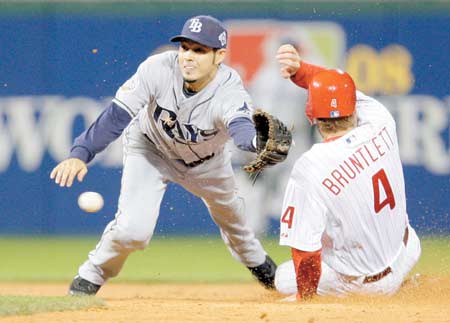
By Matthew Ralph
In all of the talk about TV ratings for the World Series this year, phrases like small market, little guy and Cinderella seem to keep coming up in references to one or both of the party-crashing opponents not named the Dodgers or the Red Sox.
But what exactly does it mean to say this is a small-market World Series or at the very least a World Series where the small-market Rays have taken a Louisville Slugger to Fox’s bottom line?
The Phillies’ brass may not always act or spend like it, but the team plays in the fourth largest TV market in the country and the sixth largest city in the country.
The Rays play in the 13th largest TV market despite playing in the 75th largest city. And while St. Petersburg is small as far as big league cities go, that No. 13 ranking doesn’t sound quite as small when you consider there are 13 other big league teams playing in a smaller TV market than the Rays.
Where the disparity between the Rays and the rest of the league really starts to show up is in payroll and attendance. Only their National League neighbors to the south with their measly $21 million blue light special had a smaller payroll in 2008. The Rays payroll was $43 million. As for putting butts in seats, the Marlins and Royals were the only teams to draw less than the 1.7 million fans (about 22,000 a game) who showed up at the Trop to see what was a first-place team in the American League East for most of the year. They played in front of an average of only about 8,000 more fans per game on the road.
The Phillies, meanwhile, invested more than twice what the Rays did for a star-studded lineup that includes two MVP winners with a $98 million money clip that ranked them 13th in the league. Sure, it’s a small price to pay to get to within one win of a World Series crown when compared to the $138 million the Tigers and Mets spent to watch the series on their couches or the $209 million the Yankees threw at aging superstars but is it fair to call it small? Their attendance was anything but small. The 3.4 million fans they drew to their bandbox to watch a lot of their games turn into home run derbies was good enough for fifth in the league. Their average road attendance was only good enough for 13th, a factor that probably speaks to the Phillies status as a smaller national market team.
Still, the question is, is all of this small enough to qualify the Phillies, at the very least, as the little guy swimming in a deep-end media market with three million-plus fans watching?
Hardly. A big market team with a medium-sized payroll and a supportive if mostly local fanbase would probably be more accurate. As for the Rays, their TV market ranking puts them more at the level of a medium-market team with a miniscule payroll and a terrible fanbase almost everywhere they go (their average road attendance even playing 18 of their games in Boston and New York was only good enough for 21st).
Rather than a battle of David versus David, this World Series is perhaps more accurately a matchup of a big market team Fox probably didn’t prefer to have go all the way with a smaller market team they for the sake of ratings and series losses by the Dodgers and Cubs absolutely did not want to see pull off the worst-to-WS feat.
Of course, none of this fits very smoothly into a headline, a lede or a blog post.
It’s much easier to call it a ratings bust of a series between two small-market clubs and start warming up the Hot Stove chatter about CC, Manny and the other top dollar free agents that only teams in New York, Boston, Los Angeles, Chicago and maybe one or two other cities might be willing to pay and able to afford.
Leave a Reply